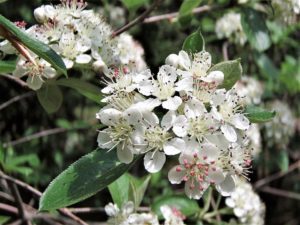Showy Swamp Rose
By Betsy Washington, Northern Neck Chapter June is always an exciting month in the many freshwater wetlands in the Northern Neck and beyond as many plants come into bloom. And one of the showiest blooms belongs to our beautiful Swamp Rose, Rosa palustris, an upright, deciduous shrub typically reaching 3 – 6’ high and wide,…
Blue-Eyed Grass Blooms for Bees and Butterflies
By Betsy Washington, Northern Neck Chapter Narrow-leaved Blue-eyed Grass (Sisyrinchium angustifolium) is a lovely small perennial typically reaching only 6 – 12” high and wide but in late spring it lights up the landscape wherever it grows. This is a “grass” only in name as it is a member of the Iris family, with linear,…
Marsh Marigold: A Spring Tonic
By Betsy Washington, Northern Neck Chapter Today, the first day of April, has dawned cold with rain and winds after a week of mild weather, and I seek solace in the first harbingers of spring. A hike to Cabin Swamp in Hickory Hollow Natural Area Preserve is just the spring tonic needed. Sure enough, the…
Redbud is Ready for Spring
By Betsy Washington, Northern Neck Chapter As signs of spring fill the air, I find myself eagerly anticipating the vibrant magenta pink blooms of one of our most beautiful flowering trees, the Eastern Redbud (Cercis canadensis). This small tree is a common sight along roadsides, woodland edges, and old fields in Virginia in late March…
Beyond the Field – Enter
By Nicola McGoff, Jefferson Chapter You drive by it every day, without notice. It is just a field. An ordinary everyday field. Square shaped or almost anyway, with very defined boundaries. Manmade boundaries stretching back through time. The sedentary, fallow field. Static and uninviting for most. A place where utility trumps esthetic. Perchance, one day…
Phasing Out the Sale and Use of Invasive Plants
Updated January 19, 2022: View the Working Group Final Report at the Virginia Legislative Information System. Virginia House Joint Resolution 527, approved unanimously in 2021, calls for a study that will explore options for phasing out the sale and use of invasive plants in Virginia’s horticultural industry, and to promote the sale and use of…
Skunk Cabbage Secrets
By Nancy Sorrells On this winter weather Valentine’s Day I decided to journey back into the forest behind our property to the secret place I know where the globally rare Swamp Pink (Helonias bullata) grows. Today’s visit was not to see Swamp Pink, which is still sleeping and will not send up its amazing pink…
Wildflower of the Year 2021 American Wisteria (Wisteria frutescens)
Wisteria frutescens is a woody liana, potentially growing to heights of 15 m; young stems are smooth or covered with small hairs pressed tightly to the stem surface. Stems climb by twining around supports in a clockwise direction. Leaves are alternate and odd-pinnately compound, 10—30 cm long. Leaves may have from 5 to 15 leaflets…
A Parasitic Lifestyle: Beechdrops and Their Relatives
By Marion Lobstein Two primary characteristics of plants are a light-capturing pigment, chlorophyll, which gives most plants a green color, and the use of this pigment to capture light energy to carry out photosynthesis to produce energy-rich food from carbon dioxide and water. This kind of plant lifestyle is known as autotrophic or self-nourishing. Indian…
Red Chokeberry Shines in All Seasons
By Betsy Washington, Northern Neck Chapter Red Chokeberry (Aronia arbutifolia) is a versatile landscape shrub that shines in all four seasons of the year. In spring, showy clusters of up to 25 pristine white, or pink-blushed flowers light up the garden. Throughout summer the foliage is a lustrous dark green, then ignites in fall with shades…










